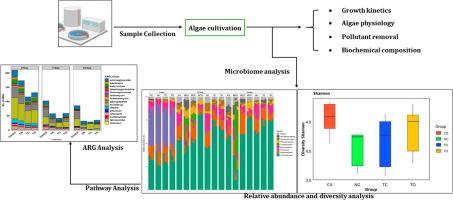Microalgae inoculation increases bacterial diversity and gene abundances related to nutrient removal while decreasing antibiotic resistant genes in municipal wastewater
IF 4.5
2区 生物学
Q1 BIOTECHNOLOGY & APPLIED MICROBIOLOGY
Algal Research-Biomass Biofuels and Bioproducts
Pub Date : 2025-07-23
DOI:10.1016/j.algal.2025.104217
引用次数: 0
Abstract
Monitoring the interactions between microalgae and microbiomes, particularly in the context of nutrient and antibiotic resistance genes (ARGs) removal from municipal wastewater treatment system, is highly recommended for the environment and public health. This study evaluated the synergistic potential of microalgae-bacteria consortia in enhancing nutrient removal and mitigating ARGs in a lab-scale microalgal municipal wastewater treatment system. Three treatments were evaluated: the two individual microalgal strains (Tetradesmus obliquus and Chlorella sorokiniana) and their mixtures (1:1). All treatments showed high removal efficiencies for phosphates (>90 %; p < 0.001), nitrates (>80 %, p < 0.001), ammonia (>90 %, p < 0.0004) and chemical oxygen demand (COD) (>65 %, p < 0.008), significantly improving water clarity and quality. Microbiome analyses revealed that microalgal inoculation altered bacterial community diversity, structure and function. Functional metagenomic profiling showed a significant enrichment (p < 0.05) of genes associated with nitrogen and phosphorus metabolism in microalgal treatment groups compared to the untreated control. Resistome analysis indicated that raw wastewater harbored a high abundance of ARGs, which were significantly reduced following microalgal treatment (p < 0.0001). Overall, our findings demonstrate a mutually beneficial interaction between microalgae and the wastewater microbiome, where microalgae-induced changes increase bacterial diversity and functional gene abundance involved in nutrient and ARG removal. These results underscore the potential of microalgae-microbiome-based systems as an effective and sustainable solution for the removal of emerging contaminants, including nutrients, ARGs and pathogens from municipal wastewater.

微藻接种增加了城市污水中与营养物去除相关的细菌多样性和基因丰度,同时减少了耐药基因
监测微藻和微生物组之间的相互作用,特别是在去除城市污水处理系统中的营养和抗生素抗性基因(ARGs)的背景下,对环境和公共卫生是强烈建议的。本研究在实验室规模的微藻城市污水处理系统中评估了微藻-细菌联合体在增强营养物去除和减轻ARGs方面的协同潜力。对两种微藻(斜四角藻和小球藻)及其混合(1:1)处理进行了评价。所有处理均显示出较高的磷酸盐去除率(90%;p & lt;0.001),硝酸盐(> 80%, p <;0.001),氨(> 90%, p <;0.0004)和化学需氧量(COD) (> 65%, p <;0.008),显著改善水质。微生物组分析表明,接种微藻改变了细菌群落的多样性、结构和功能。功能宏基因组分析显示显著富集(p <;与未处理的对照组相比,微藻处理组氮、磷代谢相关基因的含量为0.05)。抗性组分析表明,原废水中含有大量的ARGs,微藻处理后ARGs含量显著降低(p <;0.0001)。总体而言,我们的研究结果表明微藻与废水微生物组之间存在互利的相互作用,其中微藻诱导的变化增加了细菌多样性和功能基因丰度,参与营养物和ARG的去除。这些结果强调了微藻-微生物系统作为去除城市废水中新出现的污染物(包括营养物、ARGs和病原体)的有效和可持续解决方案的潜力。
本文章由计算机程序翻译,如有差异,请以英文原文为准。
求助全文
约1分钟内获得全文
求助全文
来源期刊

Algal Research-Biomass Biofuels and Bioproducts
BIOTECHNOLOGY & APPLIED MICROBIOLOGY-
CiteScore
9.40
自引率
7.80%
发文量
332
期刊介绍:
Algal Research is an international phycology journal covering all areas of emerging technologies in algae biology, biomass production, cultivation, harvesting, extraction, bioproducts, biorefinery, engineering, and econometrics. Algae is defined to include cyanobacteria, microalgae, and protists and symbionts of interest in biotechnology. The journal publishes original research and reviews for the following scope: algal biology, including but not exclusive to: phylogeny, biodiversity, molecular traits, metabolic regulation, and genetic engineering, algal cultivation, e.g. phototrophic systems, heterotrophic systems, and mixotrophic systems, algal harvesting and extraction systems, biotechnology to convert algal biomass and components into biofuels and bioproducts, e.g., nutraceuticals, pharmaceuticals, animal feed, plastics, etc. algal products and their economic assessment
 求助内容:
求助内容: 应助结果提醒方式:
应助结果提醒方式:


